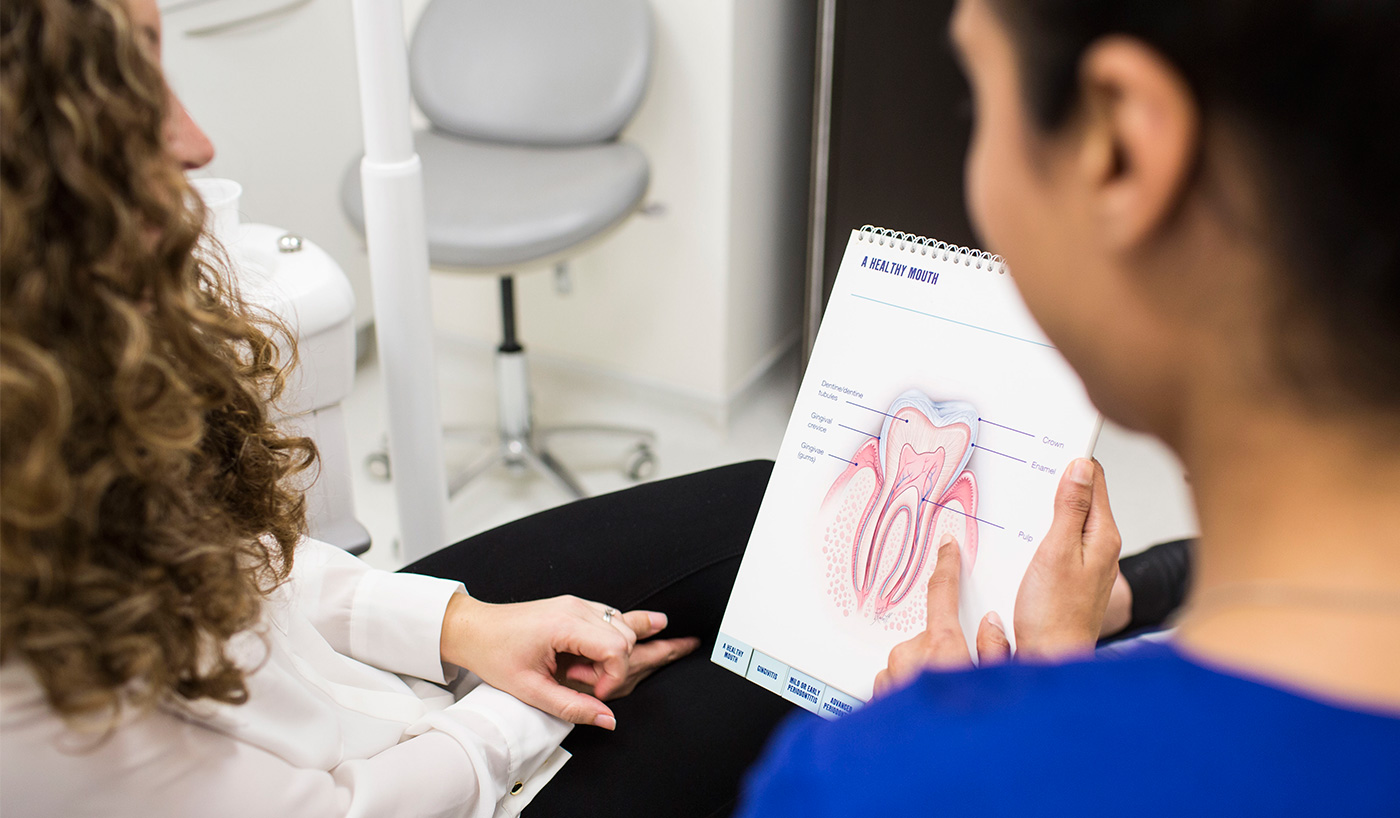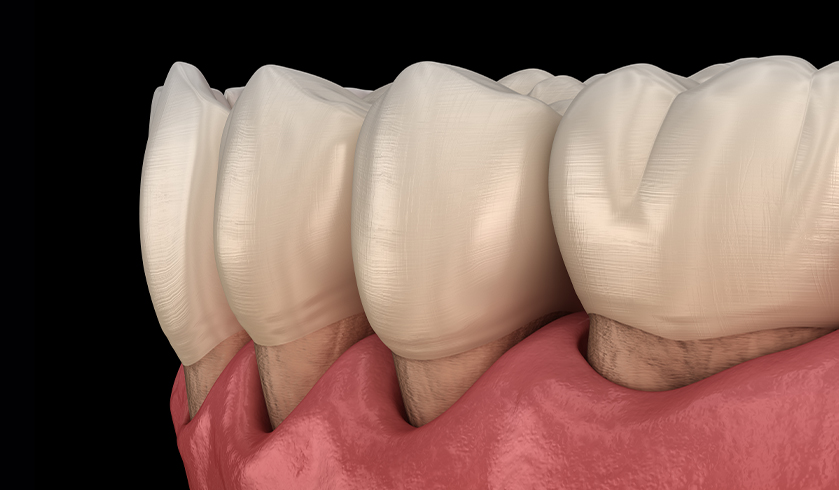Receding gums alter the appearance of your smile and affect oral health. Receding gum tissue can also make the teeth appear longer and more prominent than usual, with tooth sensitivity increasing as the root and dentin become increasingly exposed. People with receding gums can experience degenerating dental health and pain, along with a lack of self-confidence brought on by a tooth-heavy smile.
Soft tissue grafting is a dental procedure carried out to restore gum tissue lost due to gum recession. The procedure offers not only oral health benefits, but also improves cosmetic appeal so that patients once again have natural, healthy smiles.

Effects of gum recession
Leaving receding gums untreated can lead to severe gum recession, infection and tooth loss. People with untreated receding gums may also suffer with poor self-image and increased oral discomfort. As the tooth roots become exposed by receding gums, the teeth can become more sensitive and painful. Teeth may also start to become loose, affecting tooth structure and bite. Bone loss and reduced oral function can affect a person’s sense of confidence and quality of life.
Soft tissue grafting procedures are used in cases of receding gums, root exposure and also for gum tissue loss from missing teeth. People receiving dental implant treatment may benefit from gum tissue restoration, particularly if the implants are being placed within the smile zone. Transplanted gum tissue stimulates healthy gum tissue around the dental implants.
The soft tissue grafting process is also commonly used in cosmetic dentistry procedures to enhance the patient’s appearance, particularly where sufficient gum tissue is lacking around the teeth that are visible when smiling.
Other types of gum tissue grafts
Other graft types exist, such as the “pedicle graft”, which is used if enough gum tissue is present around the tooth. The tissue is taken from the tooth treatment site, pulled over the tooth root and stitched into position. Sufficient soft tissue for a graft needs to exist around the tooth, with the exposed tooth root or the damaged tooth.
Soft tissue grafts may also be obtained through other donors, such as those offered through tissue banks. Clinicians may recommend such grafts if patients are anxious about having a graft taken from their own mouths.
During gum tissue graft procedures growth proteins are used to stimulate tissue development in and around the gum treatment site. These growth proteins facilitate healing.

Questions? We've got the answers!
First an individual is assessed on their appropriateness for soft tissue grafting. If considered a suitable candidate the dentist will then recommend soft tissue grafting. Once the patient’s consent is received, the gums will then be assessed for the presence of infection. Where gum disease or infection is present the infection will be addressed first, so that it does not affect the new tissue growth.
Patients are provided with local anaesthetic for pain-free treatment, with teeth also cleaned to ensure they are free of plaque and tartar build-up. The area of the gum to be treated is then prepared for receipt of the new tissue graft.
Soft tissue used for gum tissue grafts is obtained from the roof or palate of the patient’s mouth. A dentist uses surgical procedures to remove a small amount of soft tissue, which is then stitched into the treatment site where either gum is receded or tooth root exposed.
The soft tissue removed from the palate of the patient is transplanted to build up the gum tissue where it is too thin. The grafted site at the roof of the mouth soon heals and does not cause damage to any other oral structures.
Soft tissue grafts return the gum tissue to a healthy quality to ensure tooth root is not exposed, tooth sensitivity is reduced and the danger of teeth decay and gum disease is minimised. These types of palate grafts are sometimes referred to as “free gingival grafts”.
People with bleeding and inflamed gums are encouraged to have dental check-ups and treatment to prevent further oral trauma and infection. Research indicates that a substantial number of adults are affected by gum disease. If left untreated poor gingival condition and gum disease has the potential to cause receding gums, loose teeth and tooth loss. Gingivitis and degenerating oral health also cause bad breath.
An opposite condition to a lack of gum tissue is an excess of gum tissue that causes a gummy smile. People with gummy smiles have noticeable gum tissue and small-appearing teeth. Treatment is available for both conditions. Excess gum tissue may be removed using laser gum reshaping, so that teeth look their normal, healthy length. Treatment with porcelain veneers may be combined with laser gum reshaping treatment to enhance the teeth’s appearance, especially those visible when smiling.
Clinicians provide patients who have undergone gum tissue treatment with post-operative guidelines for care and healing. Following recommended care guidelines, such as using antibacterial mouth rinse, antibiotics and painkillers, helps to reduce sensitivity, pain in the treatment area and reduces the risk of infection.
Flossing and brushing of the treated gum site should be avoided to reduce the risk of irritation and promote healthy healing. Similarly, certain food-types should also be avoided and replaced with softer foods, such as ice-cream, jelly, cooked vegetables and soft cheeses.
Patients usually resume work a day after treatment, though some discomfort may be felt. This can be alleviated through the use of painkillers. Those having experienced the palate graft may be more susceptible to sensations of discomfort. Using painkillers is considered a suitable treatment option for the pain.
Soft tissue grafting procedures range in cost, depending on the type and size of the tissue graft required. Clinicians initially assess patients and provide them with recommendations for treatment that includes a breakdown of costs.
Soft tissue grafting procedures reduce oral pain, provide greater oral hygiene and health, and promote better well-being. Once healing takes place patients may proceed with normal brushing and flossing according to oral hygiene recommendations.
Gum recession may be caused by incorrect tooth brushing technique, oral trauma or improper diet, as well as lifestyle factors such as smoking. The grafted and treated gum site is vulnerable after treatment, and gum recession may develop further if these unhealthy habits are not avoided. Not smoking, brushing the teeth according to recommended techniques and eating a balanced diet all lower the likelihood of gum recession.
There is a wide range of cosmetic dentistry treatments available for patients who have received treatment for gum recession, exposed toot roots or excess gum. Treatments such as porcelain veneers allow patients to smile with natural, healthy and white teeth. We provide custom-made teeth restorations and treatments for stained, discoloured teeth to enhance the smile.
